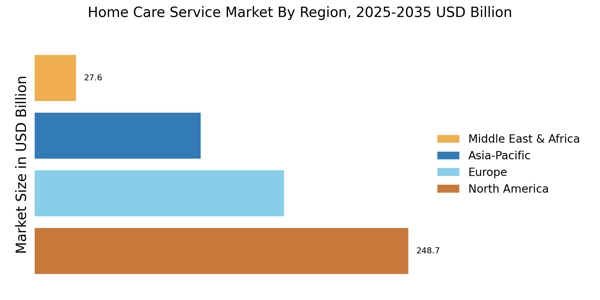Shift Towards Aging in Place
The preference for aging in place is a significant factor influencing the Home Care Service Market. Many seniors express a desire to remain in their own homes as they age, valuing the comfort and familiarity of their surroundings. This trend is supported by data indicating that over 80% of older adults prefer to stay in their homes rather than move to assisted living facilities. Consequently, families are increasingly turning to home care services to facilitate this preference, ensuring that their loved ones receive the necessary support while remaining in a familiar environment. The Home Care Service Market is likely to see continued growth as more individuals seek services that enable them to age gracefully at home.
Growing Awareness of Mental Health
The growing awareness of mental health issues is increasingly influencing the Home Care Service Market. As society recognizes the importance of mental well-being, there is a rising demand for services that address both physical and psychological needs. Many home care providers are now offering specialized programs that include mental health support, counseling, and companionship services. Research indicates that nearly 20% of older adults experience mental health conditions, such as depression and anxiety, which can significantly impact their quality of life. By integrating mental health services into home care offerings, providers can better meet the holistic needs of their clients. This trend suggests that the Home Care Service Market will continue to expand as it adapts to the comprehensive care requirements of an aging population.
Increased Family Caregiver Support
The increasing recognition of family caregivers is a vital driver of the Home Care Service Market. Many families are stepping into caregiving roles, often balancing these responsibilities with work and personal commitments. This dual role can lead to caregiver burnout, prompting families to seek professional home care services to alleviate some of the burdens. Recent surveys indicate that approximately 40% of family caregivers report feeling overwhelmed by their responsibilities. As a result, there is a growing demand for home care services that can provide respite care, skilled nursing, and assistance with daily activities. The Home Care Service Market is likely to benefit from this trend, as families increasingly turn to professional services to support their loved ones while managing their own well-being.
Rising Prevalence of Chronic Diseases
The increasing prevalence of chronic diseases such as diabetes, heart disease, and arthritis is a notable driver of the Home Care Service Market. As populations age, the incidence of these conditions rises, necessitating ongoing care and management. According to recent statistics, nearly 60% of adults aged 65 and older live with at least one chronic condition. This trend compels families to seek home care services that can provide specialized support, medication management, and daily assistance. The Home Care Service Market is thus positioned to expand as more individuals require tailored care solutions that address their specific health needs, allowing them to maintain independence while receiving necessary medical attention.
Technological Advancements in Home Care
Technological advancements are reshaping the Home Care Service Market, enhancing service delivery and patient outcomes. Innovations such as telehealth, remote monitoring, and mobile health applications are becoming integral to home care services. These technologies allow caregivers to track patients' health metrics in real-time, facilitating timely interventions and improving overall care quality. For instance, the use of telehealth services has surged, with reports indicating a 30% increase in telehealth visits among home care patients. This integration of technology not only streamlines communication between caregivers and healthcare providers but also empowers patients to take an active role in their health management. The Home Care Service Market is thus evolving to incorporate these advancements, making care more efficient and accessible.


















Leave a Comment